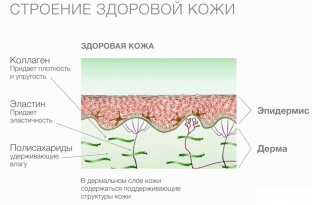One of the main criteria by which we determine the age of a person – it's the condition of his skin. Involutional processes in the body are inevitably associated with biophysical, biochemical changes in the skin. In addition, it is influenced by many external factors – such as the intensity of insolation, bad habits and lifestyle. Knowing the signs of skin aging and the reasons they are caused will help the cosmetologist choose the right program of anti-aging procedures. estet-portal.com will help you deal with the signs of skin aging.
Some external and internal signs of facial skin aging
Chronological aging of the skin is associated with internal involutional changes and is usually manifested by thinned to transparent skin, a decrease in subcutaneous fat with loss of volume of the soft tissues of the face, fine wrinkling and flabbiness of the skin, the appearance of benign changes such as angiomas or seborrheic keratosis. Environmental aging typically presents with uneven pigmentation (eg, lentigines), deep wrinkles, vascular lesions (telangiectasias), skin laxity, and xerosis.
Features of external and internal aging are various types of changes occurring at the level of the epidermis and dermis.
- Epidermis. With chronological aging, the thickness changes slightly, keratinocytes change shape, the number of melanocytes decreases, and the stratum corneum does not change. With external aging, the stratum corneum thickens, the thickness of the epidermis decreases, the number of melanosomes in keratinocytes increases, and the content of mucin decreases.
- Derma. With chronological aging, the connective tissue experiences atrophic changes, the number of fibroblasts, blood vessels, and nerve endings decreases. With external aging, the connective tissue is homogenized, the amount of collagen, glycosaminoglycans decreases, and elastosis is observed.
In both types of aging, there is a weakening of the bonds between the dermis and the epidermis.

The importance of skin moisture in the manifestation of signs of aging
The opinion that transepidermal moisture loss increases with age, and therefore skin dryness increases, is not entirely correct.
Skin barrier functions do not deteriorate with age, however, repair of the epidermal barrier, if damaged, is much slower.
The more damaged the epidermal barrier, the more moisture will be evaporate, and the moisture-retaining functions of the skin slow down with age. This must be remembered when carrying out peelings and other procedures associated with chemical or physical damage to the skin. Dry skin becomes wrinkled earlier, becomes sensitive to external influences, delivers unpleasant subjective sensations in the form of itching and tightness.
Functional signs of skin aging can be called not only a decrease in the moisture content of the stratum corneum, but also an increase in the pH level, a violation of microcirculation due to reduced capillary vasorelaxation. When With photoaging of the skin, there is also a decrease in elasticity and peeling in areas affected by insolation.
The level of elasticity of the skin is considered an indicator of its biological age, since it is associated with the level of "wear and tear"; connective tissue.
The elasticity of the skin is largely dependent on the amount of water contained in the dermis. Water molecules in the connective tissue help to tighten the elastin and collagen fibers, which increases the elasticity and firmness of the skin. With age, the ability of the connective tissue to retain water gradually decreases, which causes flabbiness of the skin.
Some recommendations for the choice of therapy depending on the signs of skin aging
When choosing one or another complex of anti-aging procedures for a patient, it is necessary to understand first of all what type of skin aging prevails: if involutional changes can only be corrected, then deformations caused by photoaging and some other external causes are reversible, and high-quality cosmetic care will give an excellent result.
Knowing the mechanism of development of skin aging processes – both chronological and external – it is possible to choose a personal program for the correction of age-related changes for the patient, while reminding him of the importance of avoiding prolonged insolation for the skin. A good result is given by biorevitalization, peelings and laser procedures, facial contouring. It is important to carry out photodocumentation before and after facial treatments – this will help both you and the patient to be convinced of the effectiveness of the cosmetic effect and the success of anti-aging therapy.







Add a comment